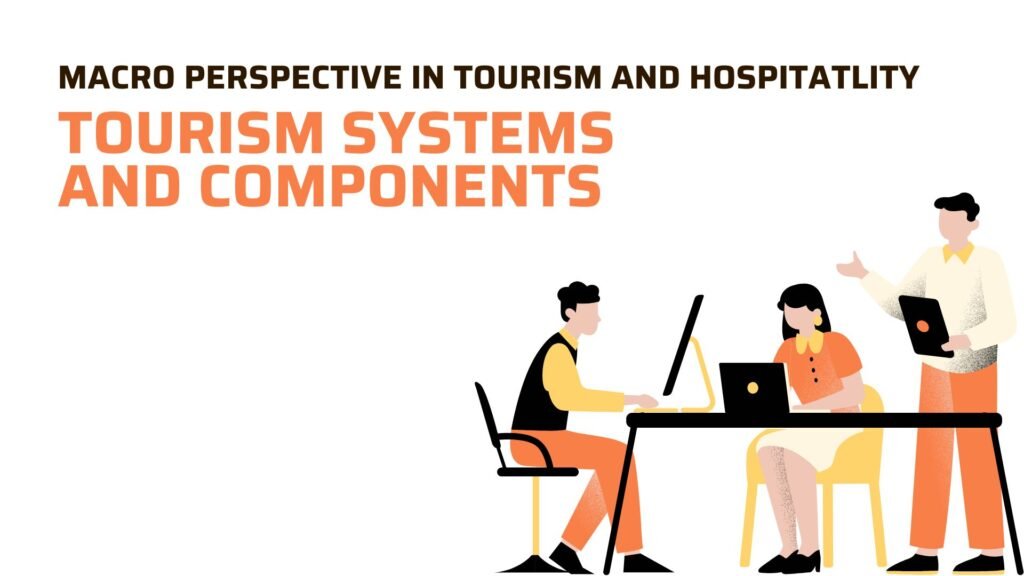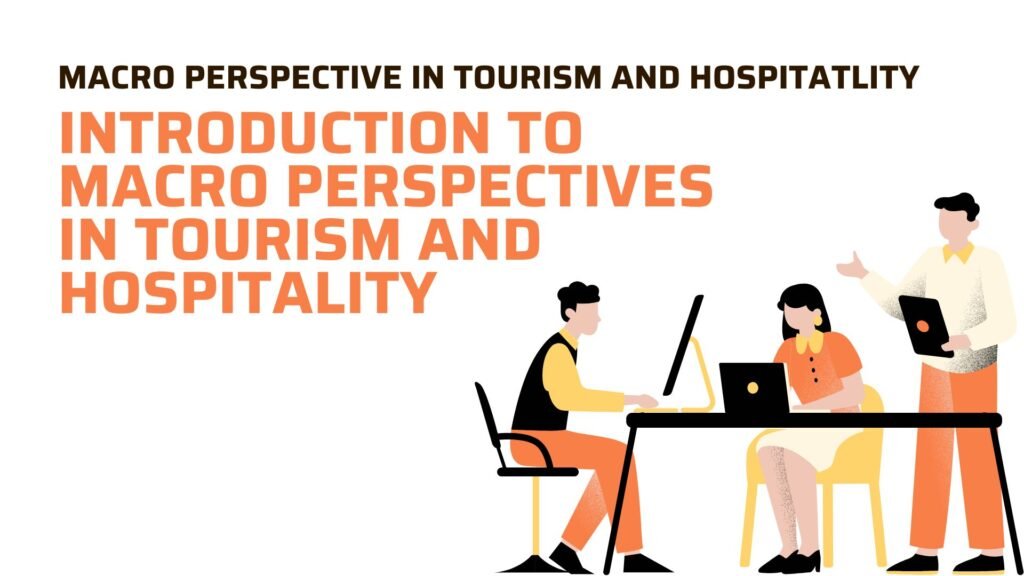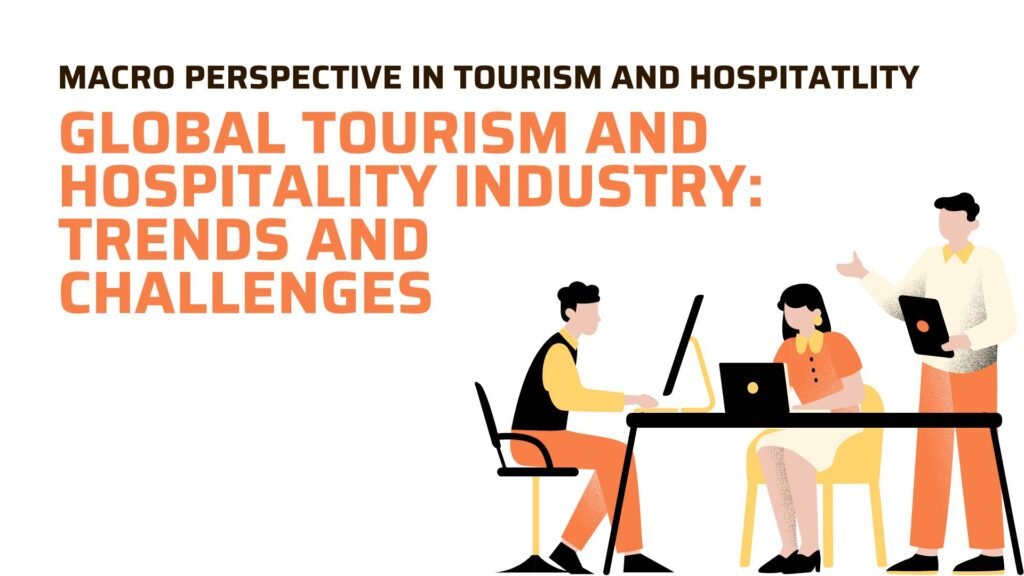
Tourism functions as a complex system with interconnected elements that collectively influence its development, operations, and impacts. Understanding these components is essential for comprehending how the industry operates at a macroeconomic level. This lesson explores the fundamental elements of the tourism system—attractions, accessibility, accommodations, and ancillary services—and their macroeconomic contributions.
Understanding Tourism as a System
Tourism operates as a system of interconnected components that collectively facilitate, sustain, and influence travel activities. These components are dynamic and interdependent, meaning changes in one component can significantly impact the others. The tourism system not only shapes the experiences of tourists but also drives economic, social, and environmental outcomes for destinations. It is a holistic framework that integrates demand, supply, and linkages, creating a complex and adaptable cycle.
Key Components of the Tourism System
1. Demand: The Desires and Motivations of Tourists
Demand in the tourism system represents the driving force behind travel activities. It reflects the reasons individuals choose to travel, the destinations they select, and the experiences they seek. Demand is influenced by a variety of factors:
- Psychological Factors: Personal motivations such as relaxation, adventure, cultural curiosity, or self-discovery play a crucial role.
- Economic Factors: Disposable income, currency exchange rates, and travel costs determine tourists’ ability and willingness to travel.
- Sociocultural Factors: Trends like solo travel, wellness tourism, or eco-tourism reflect evolving societal preferences.
- External Influences: Marketing campaigns, word-of-mouth recommendations, and media exposure significantly shape demand.
Example: The increasing popularity of sustainable travel reflects a demand shift influenced by environmental awareness, prompting destinations to offer eco-friendly experiences like wildlife safaris in Kenya or community-based tourism in Costa Rica.
2. Supply: The Resources, Services, and Infrastructure
Supply refers to the tangible and intangible elements that cater to tourist needs and fulfill their expectations during travel. It includes:
- Resources:
- Natural Resources: Scenic landscapes, beaches, mountains, and wildlife form the foundation of many tourism offerings.
- Cultural Resources: Historical sites, traditions, festivals, and local cuisines attract culturally inclined travelers.
- Services:
- Hospitality services such as accommodations, food and beverage establishments, and entertainment venues play critical roles in shaping visitor satisfaction.
- Professional services such as travel agencies, tour guides, and interpreters enhance convenience and engagement.
- Infrastructure:
- Transportation systems (airports, roads, railways) ensure accessibility.
- Utilities (water, electricity, and waste management) and technological infrastructure (internet connectivity, mobile networks) support operations.
Example: In Iceland, the government has invested in infrastructure like visitor centers and roads to support the growing number of tourists exploring its natural attractions, such as glaciers and geothermal springs.
3. Linkages: Connections Between Components
Linkages represent the networks and processes that connect demand and supply in the tourism system. These connections are vital for creating a seamless experience for travelers while optimizing economic outcomes for destinations. They include:
- Transportation Networks:
- Air travel connects international tourists to distant destinations, while local transportation systems ensure mobility within regions.
- For example, Japan’s efficient rail network links major cities and rural attractions, enhancing visitor accessibility.
- Policies and Regulations:
- Government policies on visas, customs, and travel advisories influence how easily tourists can access a destination.
- Collaborative efforts such as the Schengen Agreement facilitate cross-border travel in Europe.
- Information and Communication Flows:
- Digital platforms like social media, online travel agencies (e.g., Expedia), and review sites (e.g., TripAdvisor) bridge the gap between tourists and service providers, helping travelers make informed decisions.
- Cultural and Economic Exchanges:
- Tourism fosters cultural understanding and economic interdependence by linking visitors with local communities and businesses.
Example: The Maldives depends on efficient linkages between its supply chain (luxury resorts) and transportation (seaplanes and boats) to connect international tourists to its island destinations.
Tourism as a Cyclical System
The tourism system operates cyclically, with feedback loops between demand and supply driving continuous adaptation and evolution:
- Feedback from Demand to Supply:
- Tourist preferences and behaviors influence how destinations and businesses shape their offerings. For example, the rising demand for “bleisure” (business + leisure) travel has led hotels to create hybrid spaces combining work and relaxation.
- Feedback from Supply to Demand:
- Innovations in supply, such as new attractions, improved accessibility, or competitive pricing, can stimulate demand. For instance, the development of underwater hotels in Dubai created a unique draw for luxury travelers.
- Adaptation and Evolution:
- Destinations must remain flexible to adapt to changing trends, economic shifts, and environmental challenges. This adaptability ensures long-term sustainability and competitiveness.
Example: The COVID-19 pandemic disrupted traditional demand-supply dynamics, prompting destinations to focus on domestic tourism and invest in digital solutions like virtual tours to sustain engagement.
Key Components of the Tourism System
1. Attractions
Attractions are the core motivators that draw tourists to a destination. They serve as the primary demand drivers in the tourism system and can be categorized as follows:
- Natural Attractions: These include beaches, mountains, forests, and national parks. For example, the Serengeti National Park in Tanzania attracts wildlife enthusiasts, while the Great Barrier Reef in Australia draws marine lovers.
- Cultural and Historical Attractions: Destinations like the Pyramids of Giza, Machu Picchu, and the Taj Mahal showcase historical and cultural heritage, appealing to history and culture enthusiasts.
- Man-Made Attractions: These include theme parks, architectural marvels, and entertainment complexes. Examples include Disneyland and the Burj Khalifa.
- Events and Festivals: Seasonal or one-time events, such as the Rio Carnival or the Olympics, create significant tourist influxes.
Macroeconomic Impact: Attractions generate revenue through entrance fees, guide services, and surrounding businesses. They also encourage job creation in areas like conservation, hospitality, and retail.
2. Accessibility
Accessibility encompasses the means and ease with which tourists can reach destinations and move within them. It includes transportation systems, infrastructure, and regulations:
- Transportation Modes:
- Air: Airlines like Emirates and Delta connect global destinations efficiently.
- Land: Rail networks, highways, and buses facilitate regional and domestic travel.
- Sea: Cruise ships and ferries provide unique travel experiences.
- Infrastructure: Airports, seaports, roads, and public transport are essential for smooth mobility. For example, Japan’s Shinkansen (bullet train) system enhances accessibility to major cities and attractions.
- Policies and Regulations: Visa requirements, border controls, and customs regulations significantly influence accessibility. For instance, the European Union’s Schengen visa allows seamless travel across multiple countries.
Macroeconomic Impact: Efficient accessibility systems enhance destination appeal, increase tourist arrivals, and stimulate investment in transportation infrastructure, benefiting both the tourism sector and local economies.
3. Accommodations
Accommodations provide the physical space for tourists to stay during their travels. They range widely in type and quality to cater to diverse preferences and budgets:
- Hotels and Resorts: These include luxury brands like Hilton, budget options like Ibis, and boutique hotels catering to niche markets.
- Alternative Lodging: Homestays, Airbnb rentals, and hostels appeal to budget-conscious and experiential travelers.
- Specialized Accommodations: Eco-lodges, heritage hotels, and cruise ships offer unique experiences aligned with specific tourist motivations.
Macroeconomic Impact: The accommodation sector is a major contributor to GDP and employment. It stimulates local economies through supply chain linkages, such as food procurement and facility maintenance.
4. Ancillary Services
Ancillary services are supplementary services that enhance the overall tourist experience. While not primary motivators, they are integral to ensuring satisfaction and convenience:
- Tour Operators and Travel Agencies: These entities facilitate trip planning, offering packages and itineraries that streamline travel logistics.
- Guides and Interpreters: Knowledgeable guides enhance tourist experiences by providing insights into attractions.
- Financial Services: Currency exchange, ATMs, and mobile payment systems ensure tourists can transact seamlessly.
- Medical Services: Accessible healthcare and travel insurance provide safety and reassurance for tourists.
- Retail and Souvenirs: Shops selling local crafts, clothing, and memorabilia contribute to the tourist experience while supporting local artisans.
Macroeconomic Impact: Ancillary services create secondary economic benefits by driving consumption, employment, and business opportunities. For example, the demand for local crafts in tourist areas supports small-scale industries.
Macroeconomic Impacts of the Tourism System
The interconnected components of the tourism system have profound effects on economies at multiple levels:
- Direct Contributions:
- Revenue from ticket sales, accommodation bookings, and transportation fees directly contributes to GDP.
- Taxes on tourism-related activities, such as airport fees and hotel taxes, provide governments with funding for public projects.
- Employment Generation:
- The tourism system creates jobs across diverse sectors, from hospitality and transportation to retail and entertainment. For instance, the Maldives tourism industry employs over 60% of its workforce.
- Multiplier Effect:
- Tourism stimulates investment in related sectors like agriculture, construction, and telecommunications, creating a ripple effect throughout the economy.
- Foreign Exchange Earnings:
- Tourism is a significant source of foreign currency, especially for developing nations. For example, Thailand generates billions annually from international tourism.
- Regional Development:
- The demand for improved accessibility and attractions often drives infrastructure development in rural or underdeveloped areas, promoting balanced regional growth.
Conclusion
The tourism system is a sophisticated network of attractions, accessibility, accommodations, and ancillary services. These components work in tandem to create compelling travel experiences while driving significant macroeconomic benefits. Recognizing the interplay between these elements is essential for stakeholders aiming to optimize the system’s efficiency, sustainability, and profitability. Through strategic management and innovation, the tourism system can continue to adapt to changing trends and challenges, securing its role as a pivotal contributor to global economic and social development.

